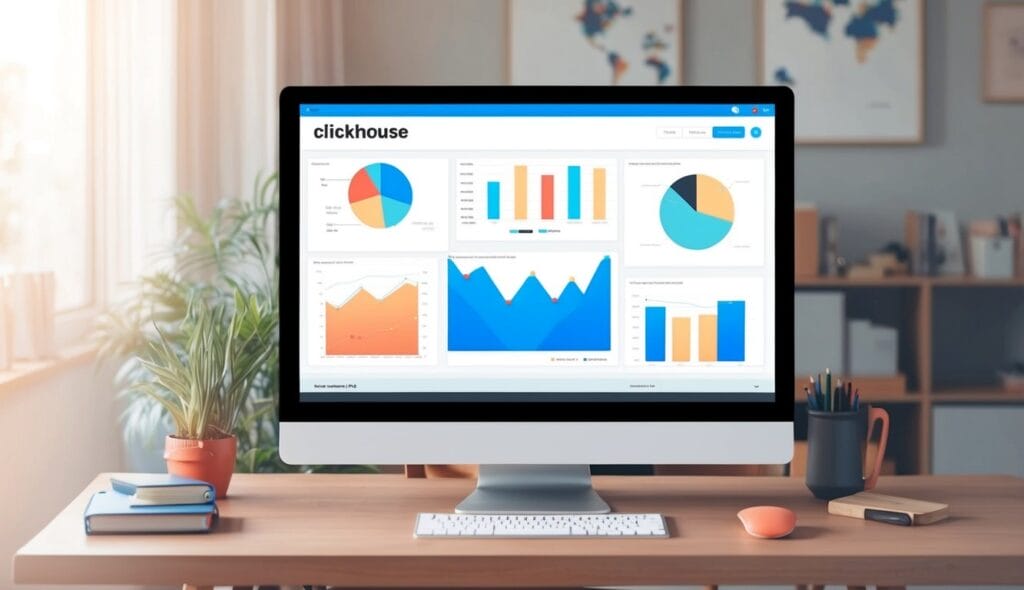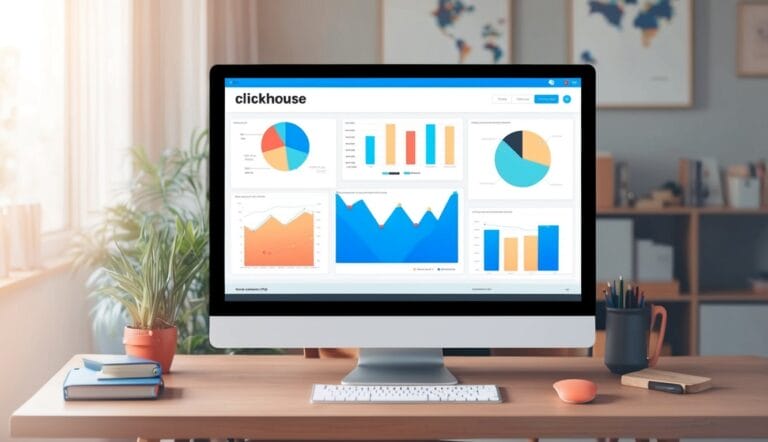ClickHouse is a powerful column-oriented database management system designed for online analytical processing (OLAP). It offers fast query performance and efficient data storage, making it a top choice for handling large datasets.

Table of Contents
ClickHouse excels at processing complex queries on massive amounts of data in real-time, making it ideal for analytics and reporting tasks. Its unique architecture allows for quick aggregations and joins, enabling businesses to gain insights from their data rapidly.
This article will explore five practical examples that showcase ClickHouse’s capabilities. From basic data operations to advanced querying techniques, these examples will help you understand how to leverage ClickHouse for your data analysis needs.
Key Takeaways
- ClickHouse provides fast query performance for large-scale data analysis
- Its column-oriented structure enables efficient storage and retrieval of information
- ClickHouse offers scalability and flexibility for diverse data processing tasks
Getting Started with ClickHouse

ClickHouse is a fast, open-source column-oriented database management system. Setting up ClickHouse involves installation and server configuration. These steps are key for using ClickHouse effectively.
Installation Guide
ClickHouse offers multiple installation options. The easiest method is using Docker. To install with Docker, first ensure Docker is set up on your system. Then, pull the ClickHouse image:
docker pull clickhouse/clickhouse-server
For a more traditional setup, download the appropriate package for your operating system from the ClickHouse website. On Ubuntu, you can use apt:
sudo apt-get install clickhouse-server clickhouse-client
After installation, the ClickHouse server and client will be ready for use.
Setting Up the ClickHouse Server
Once installed, start the ClickHouse server. With Docker, run:
docker run -d --name clickhouse-server -p 8123:8123 clickhouse/clickhouse-server
For non-Docker installations, use:
sudo service clickhouse-server start
The server’s default configuration is suitable for most use cases. To modify settings, edit the config.xml file in the ClickHouse config directory.
Connect to the server using the ClickHouse client. With Docker:
docker run -it --rm --link clickhouse-server:clickhouse-server clickhouse/clickhouse-client --host clickhouse-server
For standard installations:
clickhouse-client
The server is now ready for creating databases, tables, and running queries.
Data Structure Design
ClickHouse offers powerful tools for creating and managing databases, tables, and indexes. Proper data structure design is key to optimizing performance and storage efficiency.
Creating Databases
To create a database in ClickHouse, use the CREATE DATABASE command. This sets up a new storage space for tables and data.
CREATE DATABASE my_database
ClickHouse allows multiple databases on a single server. This helps organize data for different projects or teams.
Database names must be unique. They can contain letters, numbers, and underscores. It’s good practice to use clear, descriptive names.
Defining Tables and Data Types
Tables in ClickHouse store the actual data. The CREATE TABLE command defines a table’s structure.
CREATE TABLE my_table (
id UInt32,
name String,
date Date,
value Float64
) ENGINE = MergeTree()
ClickHouse supports many data types, including integers, floats, strings, and dates. Choosing the right data type is crucial for performance and storage efficiency.
The MergeTree engine is often used. It’s good for analytical queries on large datasets. Other engine options exist for specific use cases.
Primary Keys and Indexing
Primary keys in ClickHouse are different from traditional databases. They determine data sorting and help with query optimization.
CREATE TABLE events (
timestamp DateTime,
user_id UInt32,
event_type String
) ENGINE = MergeTree()
PRIMARY KEY (timestamp, user_id)
The primary key doesn’t have to be unique. ClickHouse uses sparse indexing, which means not every row is indexed. This saves space and speeds up large table scans.
Choosing a good primary key depends on your query patterns. It’s often best to put frequently filtered columns first in the key.
Advanced Data Operations
ClickHouse offers powerful tools for complex data handling. These features allow for efficient storage and quick access to large datasets.
Utilizing MergeTree Engine
The MergeTree engine is a key component of ClickHouse. It provides fast data insertion and efficient querying.
MergeTree uses data compression to reduce storage needs. This helps save space while keeping query speeds high.
The engine organizes data into parts. Each part contains sorted rows. This structure allows for quick data retrieval.
MergeTree supports various index types. These include primary key, skip index, and others. Indexes speed up data lookups.
To create a MergeTree table:
CREATE TABLE example (
id UInt32,
date Date,
value String
) ENGINE = MergeTree()
ORDER BY (date, id);
This setup sorts data by date and id. It enables fast filtering on these columns.
Implementing Materialized Views
Materialized views in ClickHouse store pre-computed results. They speed up complex queries by having data ready.
To create a materialized view:
CREATE MATERIALIZED VIEW daily_summary
ENGINE = SummingMergeTree()
ORDER BY (date, category)
AS SELECT
date,
category,
COUNT(*) AS total
FROM raw_data
GROUP BY date, category;
This view calculates daily totals by category. It updates automatically when new data arrives.
Materialized views can use different engines. SummingMergeTree is good for aggregations. AggregatingMergeTree works well for more complex calculations.
Views can greatly improve query performance. They’re especially useful for frequently run reports or dashboards.
Scalability and Performance Tuning
ClickHouse offers powerful tools for scaling databases and boosting query speed. Key strategies focus on setting up clustered environments and fine-tuning analytical queries.
Working with Clustered Environments
Clustered environments in ClickHouse allow for improved scalability and performance. To set up a cluster, distribute data across multiple servers. This spreads the workload and enables parallel processing.
Use the Distributed table engine to query data from all cluster nodes. This engine allows seamless data access across the entire cluster.
Configure replication for data redundancy and high availability. Replicated tables ensure data is copied to multiple nodes, reducing the risk of data loss.
Optimize network settings for cluster communication. Adjust buffer sizes and timeouts to match your network capabilities and query patterns.
Monitor cluster health regularly. Use system tables to track node status, query execution, and resource usage across the cluster.
Optimizing Analytical Queries
Query optimization is crucial for fast data analysis in ClickHouse. Start by choosing the right data types and codecs for your columns. This improves storage efficiency and query speed.
Use materialized views to pre-aggregate data. This can dramatically speed up common aggregation queries.
Leverage ClickHouse’s columnar storage by selecting only necessary columns in your queries. This reduces I/O and improves query performance.
Employ proper indexing strategies. Use primary keys and skip indexes to help ClickHouse quickly locate relevant data.
Utilize the PREWHERE clause for more efficient filtering. This optimizes data reading before the main WHERE clause is applied.
Consider using the S3 table function for cost-effective storage of large datasets. This allows querying data directly from S3 buckets.
Integrations and Extensibility
ClickHouse offers many ways to connect with other tools and expand its capabilities. This allows users to create powerful data pipelines and customize ClickHouse for their needs.
Connecting with External Tools
ClickHouse supports over 100 integrations across various categories. These include language clients, data ingestion tools, SQL clients, and data visualization platforms.
For data ingestion, ClickHouse can connect with Apache Kafka. Users can set up a Kafka ClickPipe in ClickHouse Cloud to stream data efficiently.
ClickHouse also integrates with popular visualization tools like Grafana. This allows users to create interactive dashboards and charts from their ClickHouse data.
For developers, ClickHouse offers language-specific clients. These let programmers interact with ClickHouse using their preferred programming languages.
Extending Functionality through Docker
Docker provides a flexible way to deploy and extend ClickHouse. Users can run ClickHouse in a Docker container, making it easy to set up and manage.
ClickHouse examples on GitHub show how to create ClickHouse clusters using Docker Compose. These examples include setups with multiple nodes, shards, and replicas.
Docker containers allow users to add custom components to their ClickHouse setup. This can include additional tools for monitoring, backup, or data processing.
By using Docker, teams can create consistent ClickHouse environments across development, testing, and production systems. This helps ensure smooth deployments and reduces configuration issues.
Operational Insights
ClickHouse provides powerful tools for monitoring system performance and analyzing data. These capabilities help businesses track key metrics and gain valuable insights from their information.
Monitoring and Logging
ClickHouse offers robust monitoring and logging features. Users can track query performance, system resources, and error rates. The system logs important events and metrics automatically.
Admins can set up custom dashboards to visualize key performance indicators. This helps spot issues quickly and optimize system resources.
ClickHouse supports integration with popular monitoring tools. These include Prometheus, Grafana, and Zabbix. This allows teams to use familiar interfaces for tracking ClickHouse metrics.
Log data can be stored directly in ClickHouse tables. This enables fast searching and analysis of log entries. Teams can quickly investigate issues by querying log data.
Data Analytics and Visualization
ClickHouse excels at real-time analytics. Its columnar storage and parallel processing allow rapid analysis of large datasets.
Users can run complex queries on billions of rows in seconds. This speed enables interactive data exploration and quick insights.
ClickHouse integrates with many visualization tools. Popular options include Tableau, Superset, and Redash. These tools help create informative dashboards and reports.
Materialized views in ClickHouse can pre-aggregate data. This speeds up common queries and improves dashboard performance.
ClickHouse’s SQL dialect supports a wide range of analytical functions. These include window functions, complex aggregations, and time series analysis.
Frequently Asked Questions
ClickHouse offers powerful features and functions for data analysis and management. Users often have questions about its capabilities and best practices for optimal performance.
What are the most powerful date functions available in ClickHouse?
ClickHouse provides robust date functions for data analysis. The toYYYYMMDD function converts dates to a numeric format. Other useful functions include toDate, toDateTime, and dateDiff.
These functions allow easy manipulation of date and time data. Users can extract specific parts of dates or perform calculations between different time periods.
How can I use WITH FILL and INTERPOLATE features in ClickHouse?
WITH FILL and INTERPOLATE are useful for handling missing data points. WITH FILL adds rows for missing values in a specified range. INTERPOLATE estimates values between known data points.
These features help create complete datasets for analysis. They’re especially useful for time-series data where gaps may exist.
Can you provide some efficient ways to utilize primary keys and ORDER BY in ClickHouse?
Primary keys and ORDER BY clauses are crucial for optimizing query performance in ClickHouse. Choose primary keys that match common filtering patterns in your queries.
Use ORDER BY to sort data within partitions. This can significantly speed up range queries and aggregations.
How do I perform operations on multiple columns in ClickHouse?
ClickHouse allows operations on multiple columns using various functions. The arrayMap function is particularly useful for applying operations to array columns.
For non-array columns, use standard SQL operators or ClickHouse-specific functions. These can combine or transform data from multiple columns efficiently.
In what scenarios is ClickHouse not an ideal choice?
ClickHouse excels at analytical queries on large datasets. However, it may not be suitable for transactional workloads requiring frequent small updates.
It’s also not ideal for scenarios needing complex joins between many tables. ClickHouse optimizes for read-heavy workloads rather than write-intensive operations.
Which industry-leading companies have integrated ClickHouse into their tech stack?
Many prominent companies use ClickHouse for data analysis. Uber uses it for real-time analytics on trip data. Cloudflare employs ClickHouse for processing large volumes of network logs.
Other notable users include Spotify, Alibaba, and Yandex. These companies leverage ClickHouse’s speed and scalability for their data processing needs.


